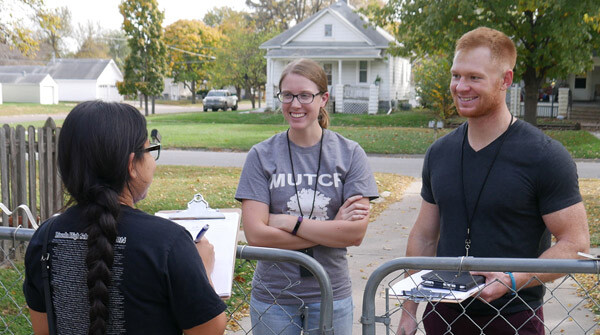
University of Nebraska-Lincoln graduate students are working with local officials to further community improvement plans for one of Lincoln’s oldest neighborhoods.
Collaborating with Lincoln and Lancaster County agencies, Nebraska graduate students pursuing a community and regional planning degree have expanded a database on the physical conditions of Lincoln’s South Salt Creek neighborhood. The work was a semester-long master’s studio project in fall 2016 that allowed Nebraska students to conduct a door-to-door survey of South Salt Creek residents.
The work is a continuation of a 2010 pilot project, funded by Woods Charitable Fund, which focused on assessing housing in several older Lincoln neighborhoods. Both the original assessment and new work in the South Salt Creek neighborhood were prompted by resident concerns about vacant and neglected properties, graffiti, weeds, litter and other safety and quality-of-life concerns.
Project collaborators include Nebraska’s College of Architecture, NeighborWorks Lincoln, the Lincoln/Lancaster County planning department and Lincoln’s urban development department.
The South Salt Creek neighborhood was selected because NeighborWorks is in the process of developing moderate- to low-income housing options in the area, either through new construction and/or rehabilitating existing homes.
As part of the collaboration, the College of Architecture agreed to participate in the data collection and analysis process. Along with the door-to-door surveys, students conducted condition-of-properties observational surveys that use 35 physical conditions criteria. In addition to the questionnaires, the team met with neighborhood residents to inform the community about their work and gauge interest for future grassroots efforts. The students used the collected information to build a quantitative database for NeighborWorks and community leaders.
“This was a great opportunity for students to conduct field work, assemble and analyze data, and understand the relationship between nonprofit organizations and city governments and how they interact and work together,” said Gordon Scholz, professor and interim program director for community and regional planning.
The project also provided a foundation for future neighborhood revitalization planning efforts.
“This background information-gathering which the students conducted is a crucial first step in preparing to create a revitalization plan,” said Pat Anderson-Sifuentez, community building for NeighborWorks Lincoln. “(NeighborWorks) and (the College of Architecture) have a long history of working together, which is a win/win because it expands our capacity, provides students with hands-on experience and benefits the community.”
Anderson-Siefuentez said the student work in gathering and analyzing census data, property assessment scans and resident surveys advances the work of NeighborWorks Lincoln and community planning staff.
“At the outset in this project, Gordon Scholz, NeighborWorks staff and Lincoln Planning and Urban Development staff met to make sure that the information gathered would be put to good use,” Anderson-Sifuentez said. “The work has evolved over the years from doing just scans of properties, expanding to include resident surveys and public meetings. I hope we can continue to build on this process so that future university classes can expand what the previous classes have done.”
While the class project was completed, individual students have the option to continue working, expanding their research into the project through independent study or professional projects.
“These students are improving the community they live in, and projects like this also serve as a way to connect students with meaningful service learning opportunities that will engage them with the community and possibly encourage them to stay in the area after graduation,” said Shawn Ryba, chief operating officer for NeighborWorks Lincoln.
The fall project culminated with students making recommendations to NeighborWorks Lincoln. The reports are being considered by city stakeholders as they move forward with future planning and decision-making in the South Salt Creek neighborhood.
“It was great to interact with residents of the community,” said Maggie Harthoorn, a community and regional planning student who participated in the project. “It will be fun to watch the exciting future this community has in store.”
For more information on community and regional planning at Nebraska, click here.







